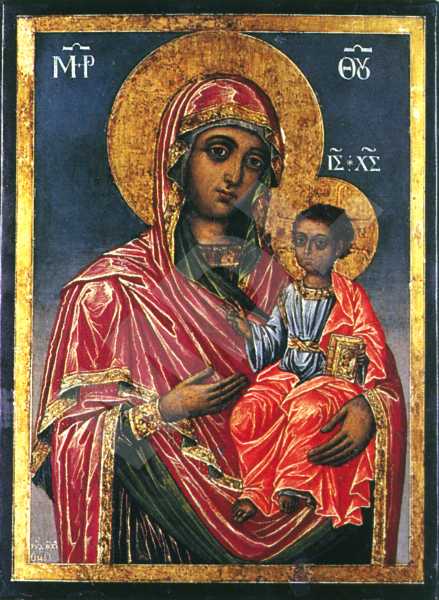The Virgin
Type:
Icon
Period:
1846 year
Dimiter T. Molerov, born in 1780 in Bansko, son of Toma Vishanov the Moler. One of the best-known painters, a representative of the Bansko school of art, a disciple of his father, influenced by the art of Athos. Author of the murals of the naos in the St Archangels' paraclete in the Rila monastery, the murals in the Church of the Assumption of the Virgin in the Pchelino dependance. In 1840 and 1841 together with his son Simeon Molerov he paints the murals and the sponsors' portraits in St. Nicholas' and St. John of Rila's paracletes in the principal church in the Rila monastery. Among D. Molerov's major achievements in iconography are the following icons: St. Nicholas (1816) from St. Archangel Michael's church in the village of Leshko, Christ All-triumphant with Angels and Cherubim (1833), The Nativity and a Crucifixion from St Elijah the Prophet's church in the village of Usenovo. He has also worked in Belgrade on an invitation by Prince Milosh Obrenovich of Serbia. He died in 1870 in Bansko.
Dimmensions (cm):
31
/ 23
/ 3
Location
Country: Bulgaria
Province: Blagoevgrad
Town: Bansko
Museum: Museum complex
Source
Country: Bulgaria
Province: Blagoevgrad
Town: Bansko
Description
The Mother of God (of the Hodegetria type) is portrayed to the waist, full face, with her head slightly bent towards the young Christ. She is dressed in the typical of her headcloth tunic with tight and long sleeves. Christ is portrayed in full length, full face, in a typical of such kind of portraits attitude (blessing with the right hand and holding a closed book in the left one). The two figures take up the entire surface of the icon. The background is a monochrome one: light greenish, slightly brightening from the top downwards.
Iconographical technique: Combined
A distemper painting with an addition of vegetable oil in the vehicle. The layer of painting is with a smooth texture, thinly applied. The modelling is a fine one, the icon having been made with the classic iconographic technique of that period. It is covered with a thin and evenly applied varnish coating.
The gilding is made on bole with gold-leaf, which had subsequently been varnished. Grounded gold had also been used in the modelling of the pleats of the garments.
Base material: Wood
The base is a one-piece softwood panel, without beams, the edges of which are shaped at an angle of 45 degree. The ground coat is of plaster. The icon's reverse is also grounded.
State, restoration traces and comments
There are no traces of any previous restoration work.


